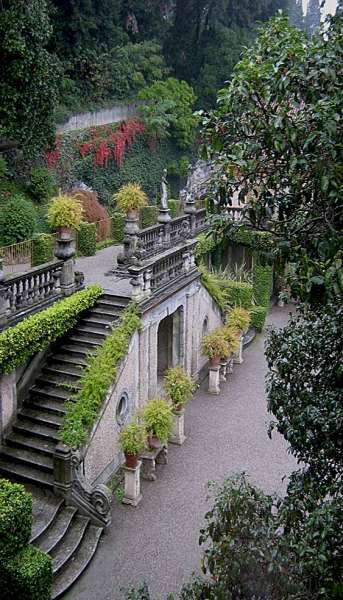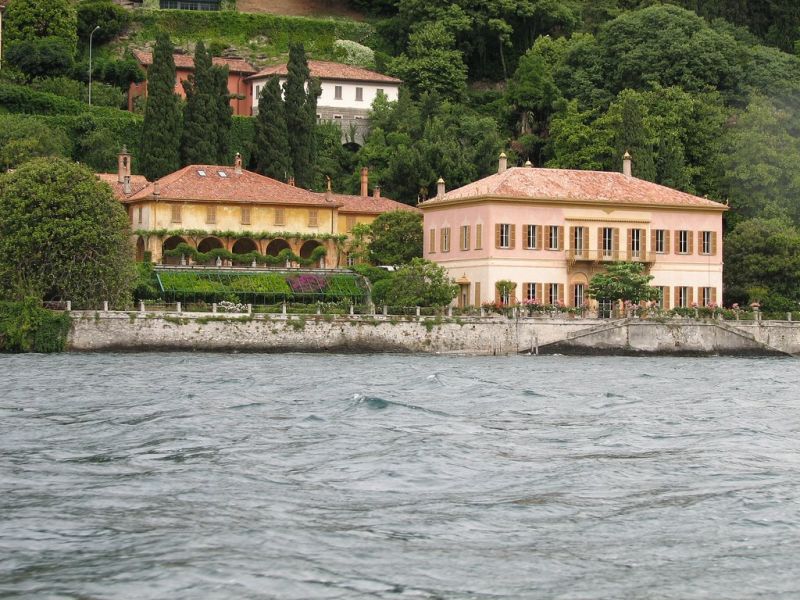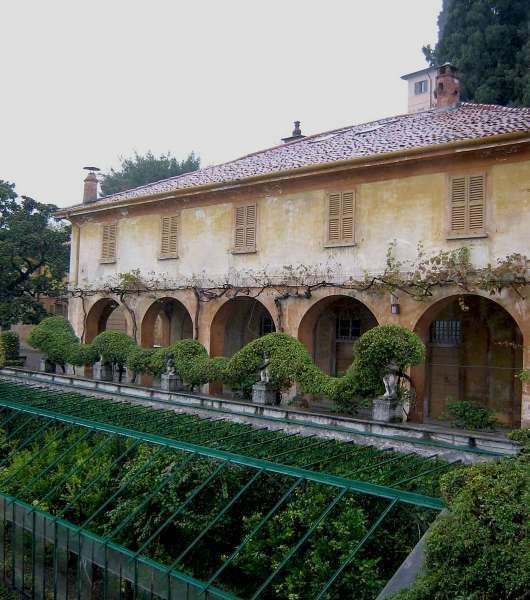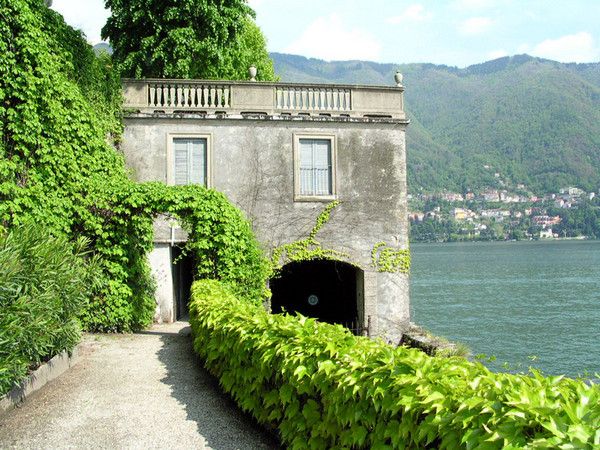 Il magnifico parco fu costruito sul promontorio localmente chiamato “Il Pizzo” dalla famiglia Mugiasca. I lavori di abbellimento del giardino iniziati nel 1600 continuarono per i secoli successivi grazie ai diversi proprietari. Il giardino che si estende a livello delle due costruzioni principali, la villa padronale e un edificio più a levante è organizzato all’italiana, con ordinati vialetti che corrono fra aiuole, siepi e fontane barocche. Sul lato occidentale sorge la darsena vecchia che si apre sul bacino di Villa d’Este mentre quella nuova, eretta dai Volpi-Bassani, domina il bacino di Moltrasio fino alla punta di Torno. Al più vasto parco si accede comodamente dal cosiddetto “Ceppo”, poco oltre la dépendance di Villa d’Este. Da qui un piccolo vialetto, un tempo detto “in Genova” per la mitezza del clima, offre un susseguirsi di piante esotiche, agavi, orchidee e altre piante rare che si arrampicano fin sull’erta scogliera; da qui si prosegue lungo il “Viale dei cipressi” con una grotta artificiale con giochi d’acqua. Percorso il viale, il parco volge a nord-est, verso Moltrasio, attraverso una fitta vegetazione di alberi ad alto fusto. Ovunque viali e sentieri si intersecano creando un arabesco che si svolge fra ponticelli, pozze d’acqua e ruscelletti. In mezzo al parco fa bella mostra di sé la fontana in onore di Volta, circondata dalle false rovine d’un tempietto classico.
Il magnifico parco fu costruito sul promontorio localmente chiamato “Il Pizzo” dalla famiglia Mugiasca. I lavori di abbellimento del giardino iniziati nel 1600 continuarono per i secoli successivi grazie ai diversi proprietari. Il giardino che si estende a livello delle due costruzioni principali, la villa padronale e un edificio più a levante è organizzato all’italiana, con ordinati vialetti che corrono fra aiuole, siepi e fontane barocche. Sul lato occidentale sorge la darsena vecchia che si apre sul bacino di Villa d’Este mentre quella nuova, eretta dai Volpi-Bassani, domina il bacino di Moltrasio fino alla punta di Torno. Al più vasto parco si accede comodamente dal cosiddetto “Ceppo”, poco oltre la dépendance di Villa d’Este. Da qui un piccolo vialetto, un tempo detto “in Genova” per la mitezza del clima, offre un susseguirsi di piante esotiche, agavi, orchidee e altre piante rare che si arrampicano fin sull’erta scogliera; da qui si prosegue lungo il “Viale dei cipressi” con una grotta artificiale con giochi d’acqua. Percorso il viale, il parco volge a nord-est, verso Moltrasio, attraverso una fitta vegetazione di alberi ad alto fusto. Ovunque viali e sentieri si intersecano creando un arabesco che si svolge fra ponticelli, pozze d’acqua e ruscelletti. In mezzo al parco fa bella mostra di sé la fontana in onore di Volta, circondata dalle false rovine d’un tempietto classico.
The magnificent park was built on the promontory known locally as “The Lace” by the family Mugiasca. The work of beautification of the garden began in 1600 continued for the following centuries thanks to the different owners. The garden that extends to the level of the two main buildings, the main villa and a building to the east is more organized with Italian ordered paths that run between flower beds, hedges and Baroque fountains. On the west side stands the old dock that opens onto the pool of Villa d’Este and the new one, built by Volpi-Bassani, dominates the basin Moltrasio to the tip of Torno. Germany’s largest park is easily accessible from the so-called “Stump”, just beyond the outbuildings of Villa d’Este. From here a small driveway, once said “in Genoa” for its mild climate, offers a series of exotic plants, agaves, orchids and other rare plants that climb far o’er the cliff; from here continue along the “Avenue of cypresses” with an artificial cave with water. Path Avenue, the park turns north-east towards Moltrasio, through dense vegetation of tall trees. Wherever avenues and paths intersect, creating an arabesque that takes place between bridges, water pools and rivulets. In the middle of the garden is a delightful self fountain in honor of Volta, surrounded by false ruins of a classical temple.






